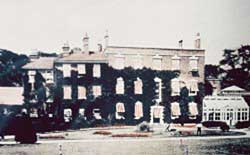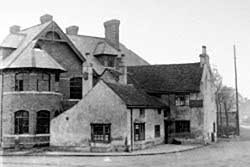
Structual
Standing Buildings
 St Giles’ church following the 1871 restoration.
St Giles’ church following the 1871 restoration.St Giles’ parish church dates from the end of the twelfth century, with evidence of the usual enhancements of its structure throughout the middle ages. It received a major restoration in 1871 which removed the medieval decoration and stained glass but resulted in what was described as a “pretty little village church”. With the rapid growth in the population of West Bridgford during the 1880s, there was a need to accommodate a much larger congregation. This resulted in sympathetic extensions in the late nineteenth and early twentieth centuries. The church has a full complement of stained glass, a medieval font, and is the home of Bridgford’s “Stone Man” which may be the effigy of one of the early Lords of the Manor. There is a history of the church, together with other material, on the local history web site.
 Bridgford Hall, c1907.
Bridgford Hall, c1907.Work was started on Bridgford Hall in 1768 by the Lord of the Manor, Mundy Musters jnr, and was completed by his son, John Musters, in 1774. Lewis Heymann, a lace manufacturer, became the tenant in 1840 and, in 1883, his son Albert bought the Hall from John Chaworth Musters. In 1923, Albert Heymann sold to West Bridgford Urban District Council: the Hall became their offices and the grounds became a public park. In 2017 the Hall underwent a major refurbishment, reopening as an apart-hotel and civil wedding ceremony venue.
A few other buildings dating back to the eighteenth century may be found in the roads close to St Giles’. The oldest cottages still used as houses are probably those bordering the churchyard, built about 1780. To the rear of the Conservative Club on Rectory Road is the former master’s house of the National School built in 1865 and used until l900.
 Trent Bridge Inn
Trent Bridge InnWest Bridgford is home both to the Nottingham Forest football ground and The Trent Bridge cricket ground. The self-styled “world famous” Trent Bridge Inn abuts the cricket ground and is the descendant of inns here on the south side of Trent Bridge. The current inn opened in 1885 and was built adjacent to its predecessor.
Listed buildings also include: the war memorial on Musters Road; Friary United Reformed Church and adjoining Sunday School on Musters Road; Musters Road Methodist Church; the Test Match Hotel on Gordon Square; the Birkin Mausoleum in Wilford Hill Cemetery; the memorial drinking fountain on Loughborough Road; the boundary wall and gates at Musters Road Methodist Church; and the boundary wall railing and gate at Lady Bay Junior School on Trent Boulevard
Ruins, earthworks and archaeological remains
 Old Trent Bridge flood arches
Old Trent Bridge flood archesThe Old Trent Bridge Flood Arches have elements dated back to the thirteenth century.
Evidence of the former Midland Railway line can be traced in various places, with part of its route now a local wildlife site, known as the Green Line, accessible for example at the former railway bridge on Devonshire Road.
Mellors notes that old maps of the Lady Bay estate show a “Barrow” or “Burrow Hill”and wonders whether there may have been a sepulchral ground there.
Landscape
The River Trent has played a major part in the landscape of West Bridgford and the course of the river has changed over time. Mellors described the geology: “The principal part of the parish rests upon a terrace of ancient gravel, and river draft, which in some places is twenty feet in depth, probably from the closing stages of the Glacial period when rivers were subject to seasonal floods of powerful volume. The Keuper Marls are below the river deposit and on the southern side of the parish they form an embankment.”
At one time there was a brook at Bridgford Road, but that was culverted many years ago. The ground rises up for around 50 metres from the River Trent to the top of Wilford Hill. Originally farmland, three turnpike roads made their way through the parish towards Trent Bridge, having their toll houses on the edge of the village. Later, the Grantham Canal and the Midland Railway line passed through the parish to Nottingham, but now are both disused.